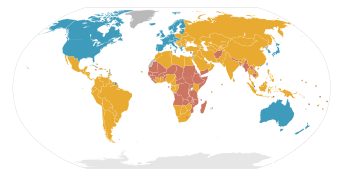发展中国家:修订间差异
无编辑摘要 |
无编辑摘要 标签:加入博客链接 |
||
| 第20行: | 第20行: | ||
[[File:Partie du Marché de Mélong (Littoral).jpg|thumb|[[喀麦隆]][[濱海省 (喀麥隆)|濱海省]]商店街]] |
[[File:Partie du Marché de Mélong (Littoral).jpg|thumb|[[喀麦隆]][[濱海省 (喀麥隆)|濱海省]]商店街]] |
||
[[File:Transport by tractor in North Korea.jpg|缩略图|[[朝鲜]]的拖拉機公車]] |
[[File:Transport by tractor in North Korea.jpg|缩略图|[[朝鲜]]的拖拉機公車]] |
||
'''发展中国家'''(也称作-{zh-cn:'''开发中国家'''、'''欠发达国家'''; zh-hk:'''開發中國家'''、'''欠發達國家'''; zh-tw:'''發展中國家'''、'''欠發達國家''';zh-sg:'''开发中国家'''、'''欠发达国家'''; zh-hant:'''開發中國家'''、'''欠發達國家''';}-,{{lang-en|'''developing country'''}}),指[[经济]]、[[社会]]方面[[发展]]程度较低的国家,與[[发达国家]]相對。 |
'''发展中国家'''(也称作-{zh-cn:'''开发中国家'''、'''欠发达国家'''; zh-hk:'''開發中國家'''、'''欠發達國家'''; zh-tw:'''發展中國家'''、'''欠發達國家''';zh-sg:'''开发中国家'''、'''欠发达国家'''; zh-hant:'''開發中國家'''、'''欠發達國家''';}-,{{lang-en|'''developing country'''}}),指[[经济]]、[[社会]]方面[[发展]]程度较低的国家,與[[发达国家]]相對。发展中国家的工业基础较不发达,[[人类发展指数]]较低。<ref>{{cite book|last1=O'Sullivan|first1=Arthur |author-link=Arthur O'Sullivan (economist)|first2=Steven M.|last2=Sheffrin | name-list-style = vanc |title=Economics: Principles in Action|url=https://archive.org/details/economicsprincip00osul|url-access=limited|publisher=Pearson Prentice Hall|year=2003|location=Upper Saddle River, New Jersey 07458|page=[https://archive.org/details/economicsprincip00osul/page/n487 471]| isbn = 978-0-13-063085-8 }}</ref>然而,这一定义并未得到普遍认同。对于哪些国家适合这一类别也没有明确共识。<ref name="UN">{{cite web | archive-url=https://web.archive.org/web/20100306024500/http://unstats.un.org/unsd/methods/m49/m49regin.htm|archive-date=6 March 2010|url = http://unstats.un.org/unsd/methods/m49/m49regin.htm#ftnc | title = Composition of macro geographical (continental) region | publisher = United Nation s}}</ref><ref name=":5">{{cite web|url=https://blogs.worldbank.org/opendata/should-we-continue-use-term-developing-world|title=Should we continue to use the term "developing world"?|date=16 November 2015|website=World Bank blogs|access-date=5 March 2020}}</ref> 发展中国家与“低收入和中等收入国家(LMIC)”一词经常互换使用,但仅指国家的经济方面。世界银行根据人均国民总收入将世界经济分为四组:高收入国家、中高收入国家、中低收入国家和低收入国家。最不发达国家、内陆发展中国家和小岛屿发展中国家都是发展中国家的亚组。频谱另一端的国家通常被称为高收入国家或[[发达国家]]。 |
||
“发展中国家”一词的使用存在争议,有些人认为它延续了“我们”和“他们”的过时概念。<ref name="Factfulness: Ten Reasons We're Wrong About The World - And Why Things Are Better Than You Think" />2015年,世界银行宣布将逐渐停止使用“发展中/发达国家分类”,更多呈现地区和收入群体的数据汇总。<ref name=":5" /><ref name=":6">{{cite web|url=https://blogs.worldbank.org/opendata/2016-edition-world-development-indicators-out-three-features-you-won-t-want-miss|title=The 2016 edition of World Development Indicators is out: three features you won't want to miss|website=blogs.worldbank.org|language=en|access-date=2020-03-05}}</ref>“全球南方”一词被一些人用作发展中国家的替代词。 |
|||
与高收入国家相比,气候变化的影响对发展中国家的影响更大,因为它们中的大多数具有高气候脆弱性或低气候复原力。<ref name=":4">{{cite journal |vauthors=Althor G, Watson JE, Fuller RA |date=February 2016 |title=Global mismatch between greenhouse gas emissions and the burden of climate change |journal=Scientific Reports |language=En |volume=6 |issue=1 |page=20281 |bibcode=2016NatSR...620281A |doi=10.1038/srep20281 |pmc=4742864 |pmid=26848052}}</ref> |
|||
== 发展中国家的一般特征 == |
== 发展中国家的一般特征 == |
||
=== 发展中国家的外部不均衡 === |
=== 发展中国家的外部不均衡 === |
||
2022年9月30日 (五) 21:39的版本




发展中国家(也称作開發中國家、欠發達國家,英語:developing country),指经济、社会方面发展程度较低的国家,與发达国家相對。发展中国家的工业基础较不发达,人类发展指数较低。[2]然而,这一定义并未得到普遍认同。对于哪些国家适合这一类别也没有明确共识。[3][4] 发展中国家与“低收入和中等收入国家(LMIC)”一词经常互换使用,但仅指国家的经济方面。世界银行根据人均国民总收入将世界经济分为四组:高收入国家、中高收入国家、中低收入国家和低收入国家。最不发达国家、内陆发展中国家和小岛屿发展中国家都是发展中国家的亚组。频谱另一端的国家通常被称为高收入国家或发达国家。
“发展中国家”一词的使用存在争议,有些人认为它延续了“我们”和“他们”的过时概念。[5]2015年,世界银行宣布将逐渐停止使用“发展中/发达国家分类”,更多呈现地区和收入群体的数据汇总。[4][6]“全球南方”一词被一些人用作发展中国家的替代词。
与高收入国家相比,气候变化的影响对发展中国家的影响更大,因为它们中的大多数具有高气候脆弱性或低气候复原力。[7]
发展中国家的一般特征
发展中国家的外部不均衡
| 此章節尚無參考來源,內容或許無法查證。 (2019年9月5日) |
人类发展指数
作為了解人類發展、經濟發展以及福祉的工具,人類發展指數 (HDI) 比較了不同國家和時間的不同經濟發展水平, 用以衡量一個國家開發程度。發展中國家是指工業基礎不發達、人類發展指數相對於其他國家較低的國家 [8]
发展中国家列表
下面所列的发展中国家绝大多数是国际货币基金组织(IMF)认定的发展中经济体。
在IMF2017年10月发布的《世界经济展望》中,193个经济体(其中香港、台灣、澳门、波多黎各不是IMF会员)的数据共同组成了《世界经济展望》数据库,它们被IMF分类为39个发达经济体和154个发展中经济体[9]。目前有5个联合国会员国(安道尔、古巴、列支敦士登、摩纳哥和朝鲜)并非IMF会员国,其中的古巴和朝鲜也被普遍视为发展中国家。因此下面共列有156个发展中国家。
主要发展中国家
其他发展中国家
| 此章節尚無參考來源,內容或許無法查證。 (2019年9月5日) |
 阿尔巴尼亚
阿尔巴尼亚 阿尔及利亚
阿尔及利亚 安哥拉
安哥拉 安地卡及巴布達
安地卡及巴布達 阿根廷
阿根廷 亞美尼亞
亞美尼亞 阿鲁巴
阿鲁巴 阿塞拜疆
阿塞拜疆 巴哈马
巴哈马 巴林
巴林 孟加拉国
孟加拉国 巴巴多斯
巴巴多斯 白俄羅斯
白俄羅斯 伯利兹
伯利兹 贝宁
贝宁 不丹
不丹 玻利维亚
玻利维亚 波黑
波黑 博茨瓦纳
博茨瓦纳 巴西
巴西 文莱
文莱 保加利亚
保加利亚 布吉納法索
布吉納法索 布隆迪
布隆迪 柬埔寨
柬埔寨 喀麦隆
喀麦隆 佛得角
佛得角 中非
中非 乍得
乍得 智利
智利 哥伦比亚
哥伦比亚 科摩罗
科摩罗 刚果民主共和国
刚果民主共和国 刚果共和国
刚果共和国 哥斯达黎加
哥斯达黎加 科特迪瓦
科特迪瓦 克罗地亚
克罗地亚 吉布提
吉布提 多米尼克
多米尼克 多米尼加
多米尼加 厄瓜多尔
厄瓜多尔 埃及
埃及 薩爾瓦多
薩爾瓦多 赤道几内亚
赤道几内亚 厄立特里亚
厄立特里亚 斯威士兰
斯威士兰 衣索比亞
衣索比亞 斐济
斐济 加彭
加彭 冈比亚
冈比亚 格鲁吉亚
格鲁吉亚 加纳
加纳 格瑞那達
格瑞那達 危地马拉
危地马拉 几内亚
几内亚 几内亚比绍
几内亚比绍 圭亚那
圭亚那 海地
海地 洪都拉斯
洪都拉斯 匈牙利
匈牙利 印度尼西亞
印度尼西亞 伊朗
伊朗 伊拉克
伊拉克 牙买加
牙买加 约旦
约旦 哈萨克斯坦
哈萨克斯坦 肯尼亚
肯尼亚 基里巴斯
基里巴斯 科索沃
科索沃 科威特
科威特 吉尔吉斯斯坦
吉尔吉斯斯坦 老挝
老挝 黎巴嫩
黎巴嫩 賴索托
賴索托 利比里亚
利比里亚 利比亞
利比亞 马达加斯加
马达加斯加 马拉维
马拉维 马来西亚
马来西亚 馬爾地夫
馬爾地夫 马里
马里 马绍尔群岛
马绍尔群岛 毛里塔尼亚
毛里塔尼亚 模里西斯
模里西斯 墨西哥
墨西哥 密克羅尼西亞聯邦
密克羅尼西亞聯邦 摩尔多瓦
摩尔多瓦 蒙古
蒙古 蒙特內哥羅
蒙特內哥羅 摩洛哥
摩洛哥 莫桑比克
莫桑比克 緬甸
緬甸 纳米比亚
纳米比亚 瑙鲁
瑙鲁 尼泊尔
尼泊尔 尼加拉瓜
尼加拉瓜 尼日尔
尼日尔 奈及利亞
奈及利亞 北馬其頓
北馬其頓 阿曼
阿曼 巴基斯坦
巴基斯坦 帛琉
帛琉 巴拿马
巴拿马 巴布亚新几内亚
巴布亚新几内亚 巴拉圭
巴拉圭 秘魯
秘魯 菲律賓
菲律賓 波蘭
波蘭 卡塔尔
卡塔尔 羅馬尼亞
羅馬尼亞 俄羅斯
俄羅斯 卢旺达
卢旺达 圣基茨和尼维斯
圣基茨和尼维斯 圣卢西亚
圣卢西亚 圣文森特和格林纳丁斯
圣文森特和格林纳丁斯 萨摩亚
萨摩亚 聖多美和普林西比
聖多美和普林西比 沙烏地阿拉伯
沙烏地阿拉伯 塞内加尔
塞内加尔 塞爾維亞
塞爾維亞 塞舌尔
塞舌尔 塞拉利昂
塞拉利昂 所罗门群岛
所罗门群岛 索马里
索马里 南非
南非 南蘇丹
南蘇丹 斯里蘭卡
斯里蘭卡 苏丹
苏丹 苏里南
苏里南 叙利亚
叙利亚 塔吉克斯坦
塔吉克斯坦 坦桑尼亚
坦桑尼亚 泰國
泰國 东帝汶
东帝汶 多哥
多哥 汤加
汤加 千里達及托巴哥
千里達及托巴哥 突尼西亞
突尼西亞 土耳其
土耳其 土库曼斯坦
土库曼斯坦 图瓦卢
图瓦卢 乌干达
乌干达 烏克蘭
烏克蘭 乌拉圭
乌拉圭 乌兹别克斯坦
乌兹别克斯坦 瓦努阿圖
瓦努阿圖 委內瑞拉
委內瑞拉 越南
越南 葉門
葉門 尚比亞
尚比亞 辛巴威
辛巴威
- 非IMF会员被視為发展中国家
已經脫離发展中国家的經濟體

下列經濟體過去被認為屬於開發中或者没有数据,但是后来被國際貨幣基金組織認定為已開發經濟體(括号内是该经济体被认定为发达的时间)。這些經濟體包含了亞洲四小龍和數個新加入歐元區的國家及地区。
 希腊(1989年)
希腊(1989年) 葡萄牙(1989年)
葡萄牙(1989年) 香港(1997年-)[11][12]
香港(1997年-)[11][12] 新加坡(1997年)[11][12]
新加坡(1997年)[11][12] 韩国(1997年)[11][12]
韩国(1997年)[11][12] 中華民國(1997年)[11][12]
中華民國(1997年)[11][12] 以色列(1997年)[11][12]
以色列(1997年)[11][12] 賽普勒斯(2001年)[13]
賽普勒斯(2001年)[13] 斯洛維尼亞(2007年)[14]
斯洛維尼亞(2007年)[14] 馬爾他(2008年)[15]
馬爾他(2008年)[15] 捷克(2009年)[16]
捷克(2009年)[16] 斯洛伐克(2009年)[16]
斯洛伐克(2009年)[16] 爱沙尼亚(2011年)[17]
爱沙尼亚(2011年)[17] 圣马力诺(2012年)[18][註 1]
圣马力诺(2012年)[18][註 1] 拉脫維亞(2014年)[19]
拉脫維亞(2014年)[19] 立陶宛(2015年)[20]
立陶宛(2015年)[20] 澳門(2016年)[10][註 1]
澳門(2016年)[10][註 1] 波多黎各(2016年)[10][註 1]
波多黎各(2016年)[10][註 1] 安道尔(2021年)[註 1]
安道尔(2021年)[註 1]
注释
参考文献
- ^ 2016年人类发展报告 (PDF). 联合国开发计划署: 198–201页. [2017-12-04]. (原始内容存档 (PDF)于2017-03-27) (英语).
- ^ O'Sullivan A, Sheffrin SM. Economics: Principles in Action
 . Upper Saddle River, New Jersey 07458: Pearson Prentice Hall. 2003: 471. ISBN 978-0-13-063085-8.
. Upper Saddle River, New Jersey 07458: Pearson Prentice Hall. 2003: 471. ISBN 978-0-13-063085-8.
- ^ Composition of macro geographical (continental) region. United Nation s. (原始内容存档于6 March 2010).
- ^ 4.0 4.1 Should we continue to use the term "developing world"?. World Bank blogs. 16 November 2015 [5 March 2020].
- ^ 引用错误:没有为名为
Factfulness: Ten Reasons We're Wrong About The World - And Why Things Are Better Than You Think的参考文献提供内容 - ^ The 2016 edition of World Development Indicators is out: three features you won't want to miss. blogs.worldbank.org. [2020-03-05] (英语).
- ^ Althor G, Watson JE, Fuller RA. Global mismatch between greenhouse gas emissions and the burden of climate change. Scientific Reports. February 2016, 6 (1): 20281. Bibcode:2016NatSR...620281A. PMC 4742864
 . PMID 26848052. doi:10.1038/srep20281 (英语).
. PMID 26848052. doi:10.1038/srep20281 (英语).
- ^ Luo et al (2022) Economic development and construction safety research: a bibliometrics approach, Safety Science, 145, 105519, https://www.sciencedirect.com/science/article/pii/S0925753521003623 (页面存档备份,存于互联网档案馆)
- ^ World Economic Outlook, October 2017, pp. 218-225. [2017-12-04]. (原始内容存档于2017-12-03).
- ^ 10.0 10.1 10.2 World Economic Outlook, April 2016, p.148 (PDF). IMF. [2016-04-23]. (原始内容存档 (PDF)于2016-04-21).
- ^ 11.0 11.1 11.2 11.3 11.4 IMF Advanced Economies List. World Economic Outlook, May 1998, p.134 (PDF). [2012-12-07]. (原始内容存档 (PDF)于2000-08-18).
- ^ 12.0 12.1 12.2 12.3 12.4 World Economic Outlook, May 1998, p.131 (PDF). IMF. [2014-05-23]. (原始内容存档 (PDF)于2000-08-18).
Note that the group of advanced economies, previously labeled industrial countries, includes Israel and four newly industrialized Asian economies, which all were added to the industrial country group in the May 1997 issue of the World Economic Outlook.
- ^ World Economic Outlook, April 2001, p.157 (PDF). [2012-12-07]. (原始内容存档 (PDF)于2001-09-13).
- ^ World Economic Outlook, April 2007, p.204 (PDF). [2012-12-07]. (原始内容存档 (PDF)于2011-11-05).
- ^ World Economic Outlook, April 2008, p.236 (PDF). [2012-12-07]. (原始内容存档 (PDF)于2011-05-16).
- ^ 16.0 16.1 World Economic Outlook, April 2009, p.184 (PDF). [2012-12-07]. (原始内容存档 (PDF)于2011-11-14).
- ^ World Economic Outlook, April 2011, p.172 (PDF). [2012-12-07]. (原始内容存档 (PDF)于2011-05-06).
- ^ World Economic Outlook, October 2012, p.180 (PDF). [2013-03-10]. (原始内容存档 (PDF)于2012-10-20).
- ^ World Economic Outlook, April 2014, p.160 (PDF). IMF. [2014-05-23]. (原始内容存档 (PDF)于2014-04-08).
- ^ World Economic Outlook, April 2015, p.150 (PDF). IMF. [2015-04-22]. (原始内容存档 (PDF)于2015-04-13).
参见
| ||||||||||||||||||||||
